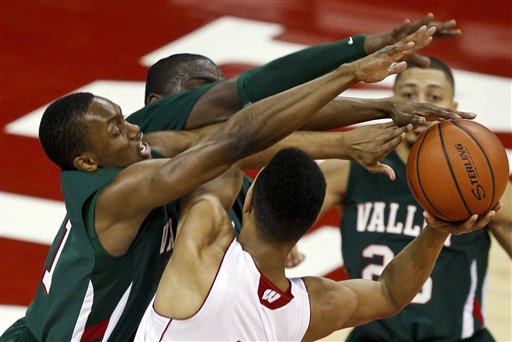Bracket Prep: Louisville, New Mexico, Ohio, & Mississippi Valley State
Posted by EJacoby on March 11th, 2012As we move through Championship Week, we’ll continue to bring you short reviews of each of the automatic qualifiers to help you fill out your bracket. In this post, we have your Big East, Mountain West, MAC, and SWAC conference champions. Here’s what you need to know about these recent bid winners.
Louisville
- Big East Champion (26-9, 14-8)
- RPI/Pomeroy/Sagarin = #18/#20/#18
- Adjusted Scoring Margin = +11.5
- Likely NCAA Seed: #4-#5
Three Bruce Pearls of Wisdom.
- Louisville might be one of the toughest teams in America to project for the NCAA Tournament, by virtue of the fact that they’ve had such a schizophrenic season full of ups and downs. After winning 11 games in a row to start the season, the Cardinals then dropped five of seven. Then, after going on another hot streak to win six Big East games in a row, Louisville dropped four of its final six regular season contests before its most recent four-game surge to win the Big East Tournament. So which team should we expect to show up next week? The story will be told in the type of opponent that Rick Pitino‘s team draws.
- Louisville has almost no offensive firepower to speak of — six players average between nine and 14 points per game, but they can’t shoot straight (48% from two; 31% from three) and have trouble avoiding long scoring droughts — rather, the Cardinals have won 26 games through its exceptionally tough defense (ranked #2 in defensive efficiency). They cause over 15 turnovers per game and force teams into tough shots both on the interior and beyond the three-point line. In the Cardinals’ last 10 games, their opponent has only reached 60 points three times. It’s somewhat instructive, though, that Louisville went 6-4 in those games because they broke the 60-point barrier only four times themselves.
- We’d suggest that you be careful in presuming that a Big East Tournament champion is poised to make a deep run in the NCAA Tournament just because they’re the Big East champion. Marquette was the only solid offensive team that the Cards defeated this week, and they’re likely to face teams that can really cause them some problems in the first two rounds. As a potential #4 or #5 seed, Louisville could be matched up against a dangerous team like Long Beach State (and Casper Ware) in the first game and a team like Creighton (and Doug McDermott) in the next round. While Pitino’s defense is likely to keep the Cards in either game, they’ll have significant trouble scoring enough points down the stretch to pull out a victory, while the other teams have players who can make plays. For that reason, this is a team that you’ll want to think carefully about putting deep into your bracket — the Cardinals can be successful playing other offensively-challenged teams, but those teams tend to not play very far into March and will be few and far between.
New Mexico
- Mountain West Champion (27-6, 13-4)
- RPI/Pomeroy/Sagarin = #29/#13/#17
- Adjusted Scoring Margin = +13.6
- Likely NCAA Seed: #5
Three Bruce Pearls of Wisdom –
- New Mexico has emerged from the wild Mountain West conference, the strong eight-team league that’s expected to produce four Tournament teams. The Lobos had established themselves as the late favorites in the conference, but a two-game losing streak in late February opened the door again for other teams. In the end, New Mexico wound up as conference co-champion of the regular season and rode the #2 seed to a tournament championship over both UNLV (on its home floor) and San Diego State (in the finals). New Mexico didn’t play a particularly strong schedule in the non-conference, nor was this the same team back in November. Therefore, its RPI is not as strong as its predictive ratings that are more indicative of this team’s high level of play throughout the year. Steve Alford has a diverse team that will be an interesting matchup.
- Drew Gordon did not win Mountain West Player of the Year, but the big man certainly had the statistical impact and big-game ability that made him a deserving candidate. Gordon was sixth in the nation in rebounding (10.9 RPG) and poured in 13.4 PPG to boot. Gordon, the UCLA transfer, is a classic big man that does nearly all of his work in the paint using his size and polished post moves. But as his points per game average shows, the New Mexico offense does not only run through him. Tony Snell has been up and down all season, but the talented off-guard (11.0 PPG) has been hot lately and scored 14 points in the MW finals, on 5-7 shooting. Kendall Williams is a strong point guard (12.0 points, 4.1 assists) that can catch fire from deep. These three players are all capable of leading the team in scoring on a given night.
- Above all else, New Mexico is a defensive juggernaut, which is an impressive attribute considering the amount of offensive playmakers on the roster. The Lobos were fourth in the country in defensive efficiency (88.6) this season, including holding opponents to 38% shooting from the field. They also have a great 53.7% rebound percentage. New Mexico plays at an average pace and yet averages over 16 assists per game, which adds up to the fourth-ranked assist percentage in America. All of these metrics make for an incredibly difficult team to execute against. New Mexico will be an interesting matchup that could receive any seed from a #4 to a #6. The Lobos don’t have the elite athletes that a high seed usually does, but the style of play and terrific execution makes for a perpetually difficult matchup. If their shots are falling, the defense and poise will make them a potential sleeper team. That said, they don’t want to run into a team with that elite athleticism that could match up with them defensively and pose a challenge on the interior. Gordon is great on offense but can be exploited a bit defensively, and then there’s a steep drop off in interior play. An athletic team like Florida State or Louisville would probably be a really bad matchup. UNM would rather run into a Vanberbilt or Wichita State if it can avoid a first-round upset.
Ohio
- MAC Champion (27-7, 14-5)
- RPI/Pomeroy/Sagarin = #51/#72/#72
- Adjusted Scoring Margin = +7.0
- Likely NCAA Seed: #13/14
Three Bruce Pearls of Wisdom –
- Ohio wasn’t one of the Mid-American Conference favorites to begin the season, and the Bobcats wound up with the #3 seed in the conference tournament. But John Groce‘s team had a very strong year, led by a star guard, and the team has shown an ability to beat top competitors this year. Ohio beat Marshall and Northern Iowa on the road in non-conference and barely dropped at Louisville, in overtime. The Bobcats didn’t have a dominant conference season and therefore didn’t have a whole lot of buzz going into the MAC tourney, but their run to a championship has us all aware once again of this team’s strong upset potential.
- D.J. Cooper does it all for this team. The small point guard (5’11”) has been a stud for three seasons now, putting up averages of 14.6 points, 5.7 assists, 3.7 rebounds, and 2.4 steals per game this season. The problem has been the fact that Cooper is a volume shooter, putting up over 220 three-pointers on the season while shooting 31.1%. His overall 34.8% from the field is not good, and therefore puts this offense in a bind from the start. That said, Cooper has the confidence and ability to make plays when the team needs a bucket, and he can get it done in crunch time, which are important traits. He’s joined by four other players that average at least 8.9 points per game. The Bobcats play pretty strong collective defense, led by Cooper’s pressure on the perimeter.
- Ohio ranks fourth in the country in steals per game at 9.4 per night. Again, it’s Cooper’s pressure defense on the perimeter that sets the tone. The Bobcats also rebound fairly well collectively and defend the three ball very well. It all adds up to a 92.5 defensive efficiency, good for 26th in the nation. They held up in a game at Louisville against another strong defensive team, but it’s difficult to see them repeating that kind of performance. There’s not a whole lot of high-level athletes on this team; even Cooper is under 6-foot and doesn’t get easy baskets like a leading scorer should. But this team will surprise an opponent if it is not prepared for pressure defense. Cooper will have to have a huge night, and other players must convert from around the basket after the guard’s penetration opens up offensive opportunities. The potential for a #13-#4 kind of upset is there if Ohio meets an unsuspecting opponent without strong guard play, such as Vanderbilt.
Mississippi Valley State
- SWAC Champion (21-12, 20-1)
- RPI/Pomeroy/Sagarin = #147/#258/#232
- Adjusted Scoring Margin = -3.9
- Likely NCAA Seed: #16
Three Bruce Pearls of Wisdom –
- The Delta Devils of Mississippi Valley State ran through the SWAC conference with ease, dropping just one game to conference foes all year. However, this team was awful in non-conference, going 1-12. The computer numbers leave MVSU as a poor team and its adjusted scoring margin is the worst of any tournament qualifier. That makes it all the more impressive that Sean Woods led this team to a 20-1 finish after a 1-12 start. It also means that the SWAC could be the worst conference in America. MVSU is likely headed for the First Four matchups early next week.
- The Delta Devils have three players in double figures, and five of their top six players are seniors. The veteran squad loves to shoot the three, led by Terrence Joyner who hits over two per game. Not a single player on this team is over 6’8″, making for an obvious size disadvantage. Therefore, MVSU will be putting up plenty of three-pointers to give itself any chance of pulling off an upset.
- Mississippi Valley State has a 97.8 offensive efficiency, which ranks just 252nd in the country. Incredibly, that’s actually the best in their conference. The SWAC truly was probably the worst conference in the country. But MVSU dominated foes based on an up-tempo pace and perimeter-oriented offense. The Delta Devils are below-average defensively but do force a lot of turnovers, over 16 per game. This team will want to get into a hectic pace and try to bomb threes and force mistakes in its pursuit of an upset. It’s highly unlikely, especially because it will probably match up first in the First Four against another #16 seed.














































